High Sensitivity pH Sensor Based on Porous Silicon (PSi) Extended Gate Field-Effect Transistor
Abstract
:1. Introduction
2. Materials and Methods
2.1. The Porous Silicon Formation
2.2. The Sensor Chip Fabrication
2.3. Measurement Processes
3. Results and Discussion
3.1. The PSi Surface Morphology
3.2. The PSi Performance as a pH Sensor
4. Conclusions
Acknowledgments
Author Contributions
Conflicts of Interest
References
- Harraz, F.A. Porous silicon chemical sensors and biosensors: A review. Sens. Actuators B Chem. 2014, 202, 897–912. [Google Scholar] [CrossRef]
- Palestino, G.; Legros, R.; Agarwal, V.; Pérez, E.; Gergely, C. Functionalization of nanostructured porous silicon microcavities for glucose oxidase detection. Sens. Actuators B Chem. 2008, 135, 27–34. [Google Scholar] [CrossRef]
- Dhanekar, S.; Islam, S.S.; Islam, T.; Shukla, A.K. Organic vapour sensing by porous silicon: Influence of molecular kinetics in selectivity studies. Phys. E Low-Dimens. Syst. Nanostruct. 2010, 42, 1648–1652. [Google Scholar] [CrossRef]
- Dhanekar, S.; Jain, S. Porous silicon biosensor: Current status. Biosens. Bioelectron. 2013, 41, 54–64. [Google Scholar] [CrossRef] [PubMed]
- RoyChaudhuri, C. A review on porous silicon based electrochemical biosensors: Beyond surface area enhancement factor. Sens. Actuators B Chem. 2015, 210, 310–323. [Google Scholar] [CrossRef]
- López-García, J.; Martín-Palma, R.J.; Manso, M.; Martínez-Duart, J.M. Porous silicon based structures for the electrical biosensing of glucose. Sens. Actuators B Chem. 2007, 126, 82–85. [Google Scholar] [CrossRef]
- Koshida, N.; Koyama, H. Visible electroluminescence from porous silicon. Appl. Phys. Lett. 1992, 60, 347–349. [Google Scholar] [CrossRef]
- Fauchet, P.M.; von Behren, J.; Hirschman, K.D.; Tsybeskov, L.; Duttagupta, S.P. Porous Silicon Physics and Device Applications: A Status Report. Phys. Status Solidi 1998, 165, 3–13. [Google Scholar] [CrossRef]
- Canham, L.T.; Cox, T.I.; Loni, A.; Simons, A.J. Progress towards silicon optoelectronics using porous silicon technology. Appl. Surf. Sci. 1996, 102, 436–441. [Google Scholar] [CrossRef]
- Ünal, B.; Parbukov, A.N.; Bayliss, S.C. Photovoltaic properties of a novel stain etched porous silicon and its application in photosensitive devices. Opt. Mater. 2001, 17, 79–82. [Google Scholar] [CrossRef]
- Balagurov, L.A.; Bayliss, S.C.; Yarkin, D.G.; Andrushin, S.Y.; Kasatochkin, V.S.; Orlov, A.F.; Petrova, E.A. Low noise photosensitive device structures based on porous silicon. Solid-State Electron. 2003, 47, 65–69. [Google Scholar] [CrossRef]
- Hadjersi, T.; Gabouze, N. Photodetectors based on porous silicon produced by Ag-assisted electroless etching. Opt. Mater. 2008, 30, 865–869. [Google Scholar] [CrossRef]
- Balucani, M.; Bondarenko, V.; Klusko, A.; Ferrari, A. Recent progress in integrated waveguides based on oxidized porous silicon. Opt. Mater. 2005, 27, 776–780. [Google Scholar] [CrossRef]
- Liyanage, C.N.; Blackwood, D.J. Functionalization of a porous silicon impedance sensor. Thin Solid Films 2014, 550, 677–682. [Google Scholar] [CrossRef]
- Massera, E.; Nasti, I.; Quercia, L.; Rea, I.; Di Francia, G. Improvement of stability and recovery time in porous-silicon-based NO2 sensor. Sens. Actuators B Chem. 2004, 102, 195–197. [Google Scholar] [CrossRef]
- Mahmoudi, B.; Gabouze, N.; Haddadi, M.; Mahmoudi, B.; Cheraga, H.; Beldjilali, K.; Dahmane, D. The effect of annealing on the sensing properties of porous silicon gas sensor: Use of screen-printed contacts. Sens. Actuators B Chem. 2007, 123, 680–684. [Google Scholar] [CrossRef]
- Kanungo, J.; Saha, H.; Basu, S. Room temperature metal–insulator–semiconductor (MIS) hydrogen sensors based on chemically surface modified porous silicon. Sens. Actuators B Chem. 2009, 140, 65–72. [Google Scholar] [CrossRef]
- Anglin, E.J.; Cheng, L.; Freeman, W.R.; Sailor, M.J. Porous silicon in drug delivery devices and materials. Adv. Drug Deliv. Rev. 2008, 60, 1266–1277. [Google Scholar] [CrossRef] [PubMed]
- Chen, C.-C.; Chen, H.-I.; Liu, H.-Y.; Chou, P.-C.; Liou, J.-K.; Liu, W.-C. On a GaN-based ion sensitive field-effect transistor (ISFET) with a hydrogen peroxide surface treatment. Sens. Actuators B Chem. 2015, 209, 658–663. [Google Scholar] [CrossRef]
- Xu, F.; Yan, G.; Wang, Z.; Jiang, P. Continuous accurate pH measurements of human GI tract using a digital pH-ISFET sensor inside a wireless capsule. Measurement 2015, 64, 49–56. [Google Scholar] [CrossRef]
- Zehfroosh, N.; Shahmohammadi, M.; Mohajerzadeh, S. High-Sensitivity Ion-Selective Field-Effect Transistors Using Nanoporous Silicon. IEEE Electron Device Lett. 2010, 31, 1056–1058. [Google Scholar] [CrossRef]
- Yao, P.-C.; Chiang, J.-L.; Lee, M.-C. Application of sol–gel TiO2 film for an extended-gate H+ ion-sensitive field-effect transistor. Solid State Sci. 2014, 28, 47–54. [Google Scholar] [CrossRef]
- Das, A.; Ko, D.H.; Chen, C.-H.; Chang, L.-B.; Lai, C.-S.; Chu, F.-C.; Chow, L.; Lin, R.-M. Highly sensitive palladium oxide thin film extended gate FETs as pH sensor. Sens. Actuators B Chem. 2014, 205, 199–205. [Google Scholar] [CrossRef]
- Batista, P.D.; Mulato, M. ZnO extended-gate field-effect transistors as pH sensors. Appl. Phys. Lett. 2005, 87, 143508–143511. [Google Scholar] [CrossRef]
- Chiu, Y.-S.; Tseng, C.-Y.; Lee, C.-T. Nanostructured EGFET pH Sensors With Surface-Passivated ZnO Thin-Film and Nanorod Array. IEEE Sens. J. 2012, 12, 930–934. [Google Scholar] [CrossRef]
- Liao, Y.-H.; Chou, J.-C. Preparation and characterization of the titanium dioxide thin films used for pH electrode and procaine drug sensor by sol–gel method. Mater. Chem. Phys. 2009, 114, 542–548. [Google Scholar] [CrossRef]
- Sardarinejad, A.; Maurya, D.; Alameh, K. The pH Sensing Properties of RF Sputtered RuO2 Thin-Film Prepared Using Different Ar/O2 Flow Ratio. Materials 2015, 8, 3352–3363. [Google Scholar] [CrossRef]
- Batista, P.; Mulato, M. Polycrystalline fluorine-doped tin oxide as sensoring thin film in EGFET pH sensor. J. Mater. Sci. 2010, 45, 5478–5481. [Google Scholar] [CrossRef]
- Chou, J.-C.; Kwan, P.K.; Chen, Z.-J. SnO2 Separative Structure Extended Gate H+ Ion Sensitive Field Effect Transistor by the Sol–Gel Technology and the Readout Circuit Developed by Source Follower. Jpn. J. Appl. Phys. 2003, 42, 6790. [Google Scholar] [CrossRef]
- Reddy, R.R.K.; Chadha, A.; Bhattacharya, E. Porous silicon based potentiometric triglyceride biosensor. Biosens. Bioelectron. 2001, 16, 313–317. [Google Scholar] [CrossRef]
- Reddy, R.R.K.; Basu, I.; Bhattacharya, E.; Chadha, A. Estimation of triglycerides by a porous silicon based potentiometric biosensor. Curr. Appl. Phys. 2003, 3, 155–161. [Google Scholar] [CrossRef]
- Schöning, M.; Simonis, A.; Ruge, C.; Ecken, H.; Müller-Veggian, M.; Lüth, H. A (Bio-) Chemical Field-Effect Sensor with Macroporous Si as Substrate Material and a SiO2/LPCVD-Si3N4 Double Layer as pH Transducer. Sensors 2002, 2, 11–22. [Google Scholar] [CrossRef]
- Yates, D.E.; Levine, S.; Healy, T.W. Site-binding model of the electrical double layer at the oxide/water interface. J. Chem. Soc. Faraday Trans. 1 Phys. Chem. Condens. Phases 1974, 70, 1807–1818. [Google Scholar] [CrossRef]
- Tae-Eon, B.; Hyun-June, J.; Se-Won, L.; Won-Ju, C. Enhanced Sensing Properties by Dual-Gate Ion-Sensitive Field-Effect Transistor Using the Solution-Processed Al2O3 Sensing Membranes. Jpn. J. Appl. Phys. 2013, 52, 06GK03. [Google Scholar]
- Oldham, K.B. A Gouy–Chapman–Stern model of the double layer at a (metal)/(ionic liquid) interface. J. Electroanal. Chem. 2008, 613, 131–138. [Google Scholar] [CrossRef]
- Pan, T.-M.; Huang, M.-D.; Lin, C.-W.; Wu, M.-H. Development of high-κ HoTiO3 sensing membrane for pH detection and glucose biosensing. Sens. Actuators B Chem. 2010, 144, 139–145. [Google Scholar] [CrossRef]
- Parizi, K.B.; Yeh, A.J.; Poon, A.S.Y.; Wong, H.S.P. Exceeding Nernst limit (59 mV/pH): CMOS-based pH sensor for autonomous applications, Electron Devices Meeting (IEDM). In Proceedings of the 2012 IEEE International, San Francisco, CA, USA, 10–13 December 2012; pp. 24.7.1–24.7.4.
- Spijkman, M.; Smits, E.C.P.; Cillessen, J.F.M.; Biscarini, F.; Blom, P.W.M.; de Leeuw, D.M. Beyond the Nernst-limit with dual-gate ZnO ion-sensitive field-effect transistors. Appl. Phys. Lett. 2011, 98, 043502. [Google Scholar] [CrossRef]
- Mahmoud, N.; Hassan, Z.; Abd, H.R. Design of Metal-Semiconductor-Metal Photodetector: Porous Silicon Photodetector; Lap Lambert Academic Publishing GmbH KG: Saarbrücken, Germany, 2012. [Google Scholar]
- Yin, L.-T.; Chou, J.-C.; Chung, W.-Y.; Sun, T.-P.; Hsiung, S.-K. Separate structure extended gate H+ ion sensitive field effect transistor on a glass substrate. Sens. Actuators B Chem. 2000, 71, 106–111. [Google Scholar] [CrossRef]
- Huang, Y.-C.; Tai, F.-S.; Wang, S.-J. Preparation of TiO2 nanowire arrays through hydrothermal growth method and their pH sensing characteristics. Jpn. J. Appl. Phys. 2014, 53, 06JG02. [Google Scholar] [CrossRef]
- Liu, C.-C.; Bocchicchio, B.C.; Overmyer, P.A.; Neuman, M.R. A Palladium-Palladium Oxide Miniature pH Electrode. Science 1980, 207, 188–189. [Google Scholar] [CrossRef] [PubMed]
- Guidelli, E.J.; Guerra, E.M.; Mulato, M. V2O5/WO3 Mixed Oxide Films as pH-EGFET Sensor: Sequential Re-Usage and Fabrication Volume Analysis. ECS J. Solid State Sci. Technol. 2012, 1, N39–N44. [Google Scholar] [CrossRef]
- Fulati, A.; Usman Ali, S.M.; Riaz, M.; Amin, G.; Nur, O.; Willander, M. Miniaturized pH Sensors Based on Zinc Oxide Nanotubes/Nanorods. Sensors 2009, 9, 8911–8923. [Google Scholar] [CrossRef] [PubMed]
- Li, H.-H.; Yang, C.-E.; Kei, C.-C.; Su, C.-Y.; Dai, W.-S.; Tseng, J.-K.; Yang, P.-Y.; Chou, J.-C.; Cheng, H.-C. Coaxial-structured ZnO/silicon nanowires extended-gate field-effect transistor as pH sensor. Thin Solid Films 2013, 529, 173–176. [Google Scholar] [CrossRef]
- Luc, B.; Bergveld, P. The Role of Buried OH− Sites in the Response Mechanism of Inorganic-Gate pH-Sensitive ISFETs. Sens. Actuators 1984, 6, 65–78. [Google Scholar]
- Zhou, J.; Xu, N.; Wang, Z.L. Dissolving Behavior and Stability of ZnO Wires in Biofluids: A Study on Biodegradability and Biocompatibility of ZnO Nanostructures. Adv. Mater. 2006, 18, 2432–2435. [Google Scholar] [CrossRef]
- Chou, J.C.; Chiang, J.L. Study on the amorphous tungsten trioxide ion-sensitive field effect transistor. Sens. Actuators B Chem. 2000, 66, 106–108. [Google Scholar] [CrossRef]
- Luo, X.; Xu, J.; Zhao, W.; Chen, H. Glucose biosensor based on ENFET doped with SiO2 nanoparticles. Sens. Actuators B Chem. 2004, 97, 249–255. [Google Scholar] [CrossRef]
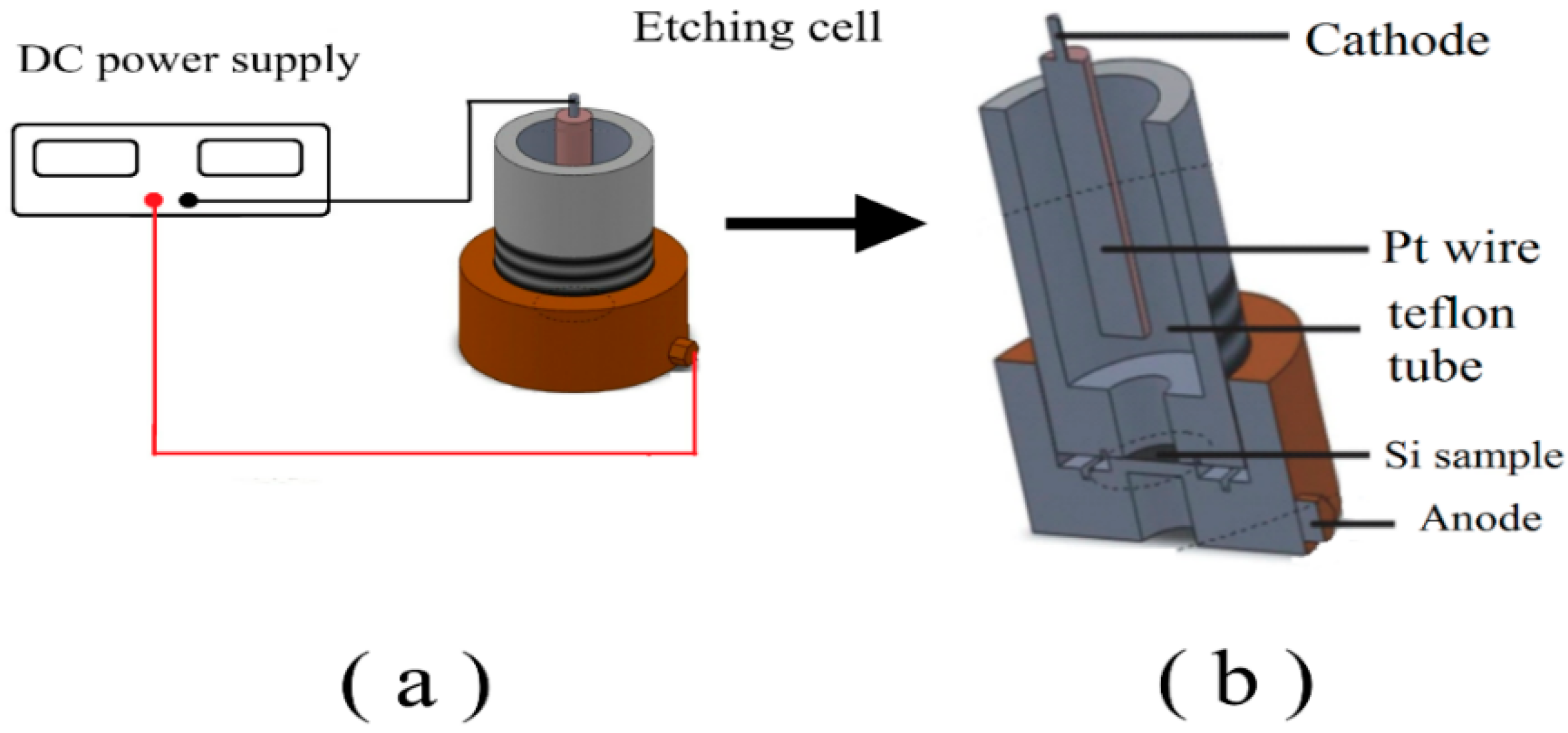

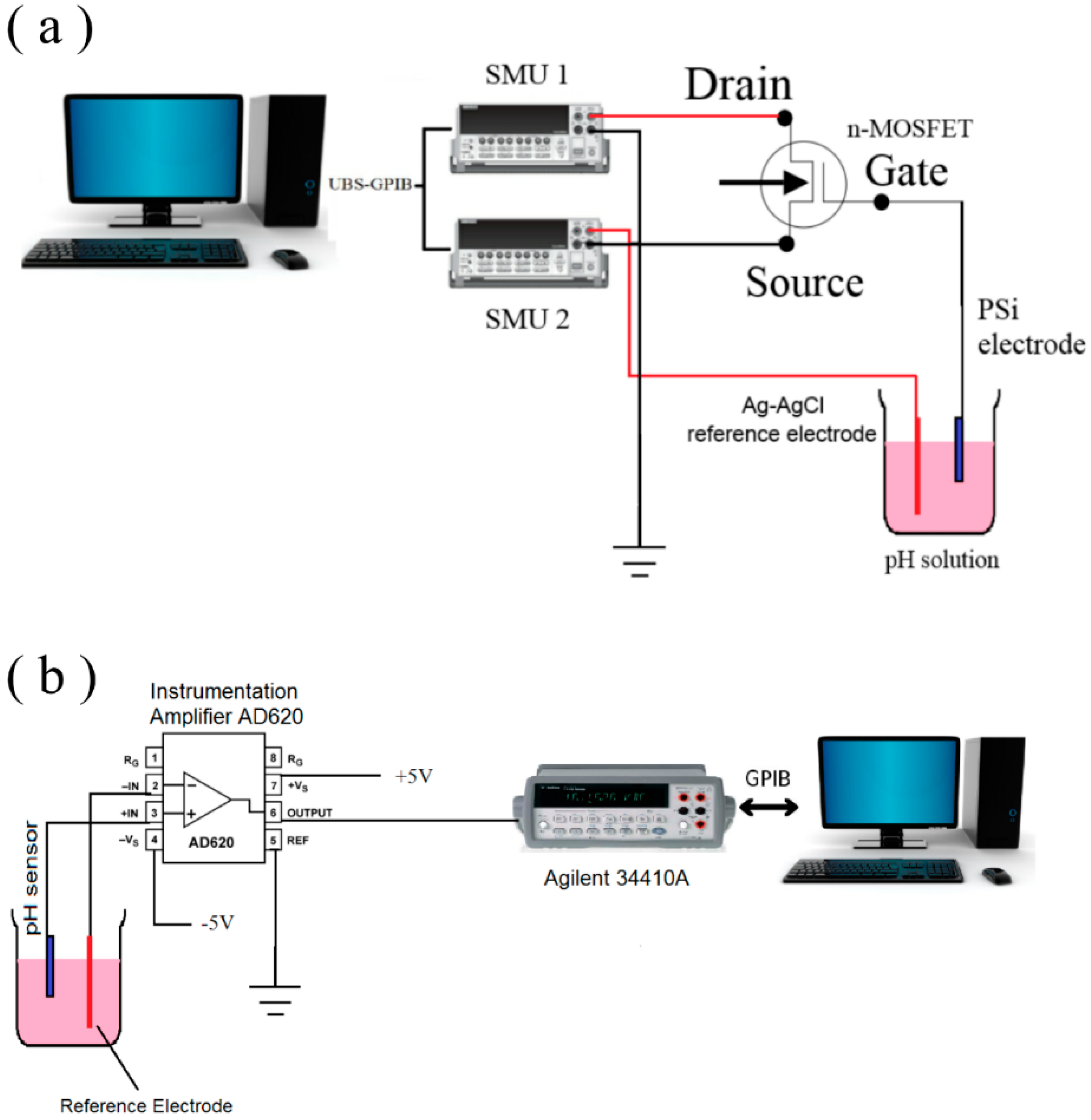
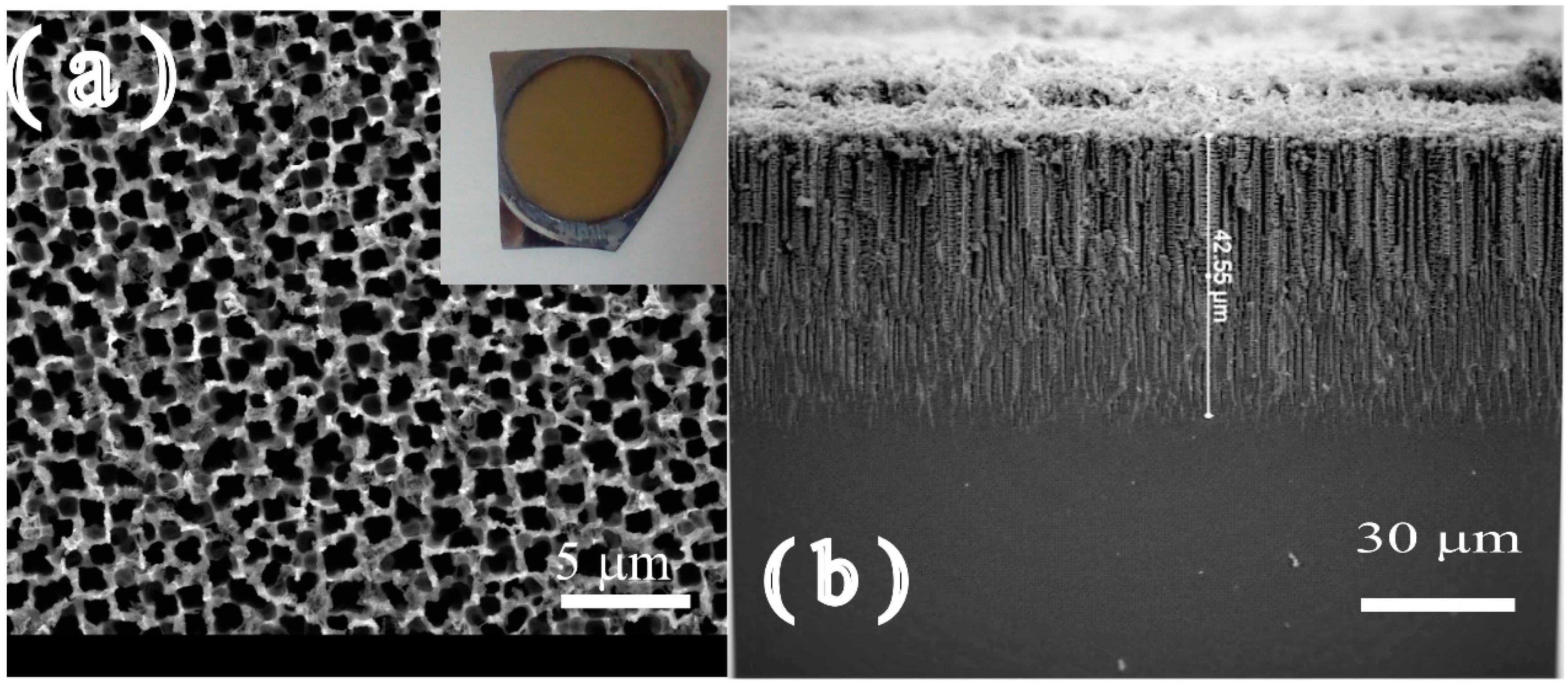
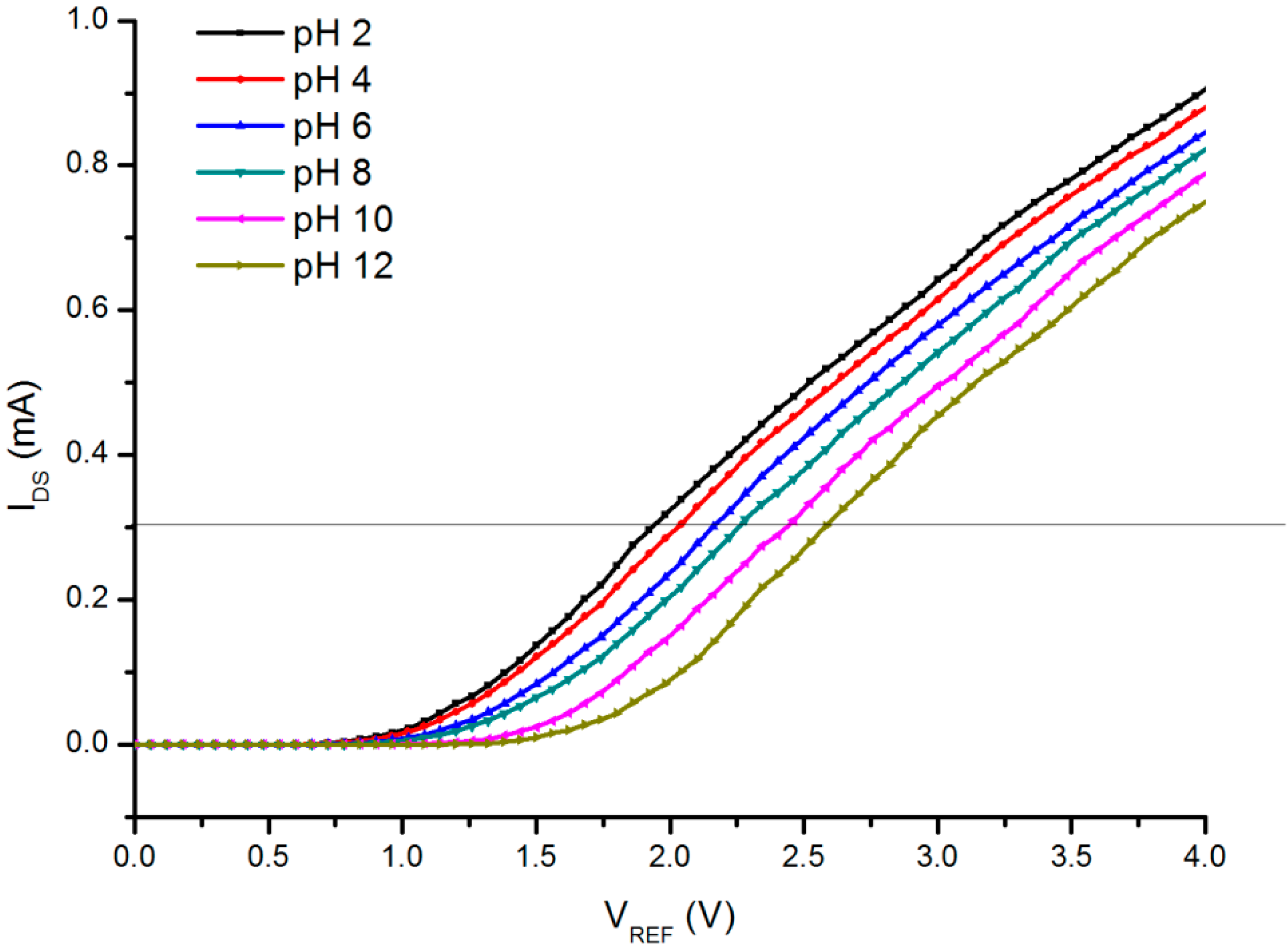
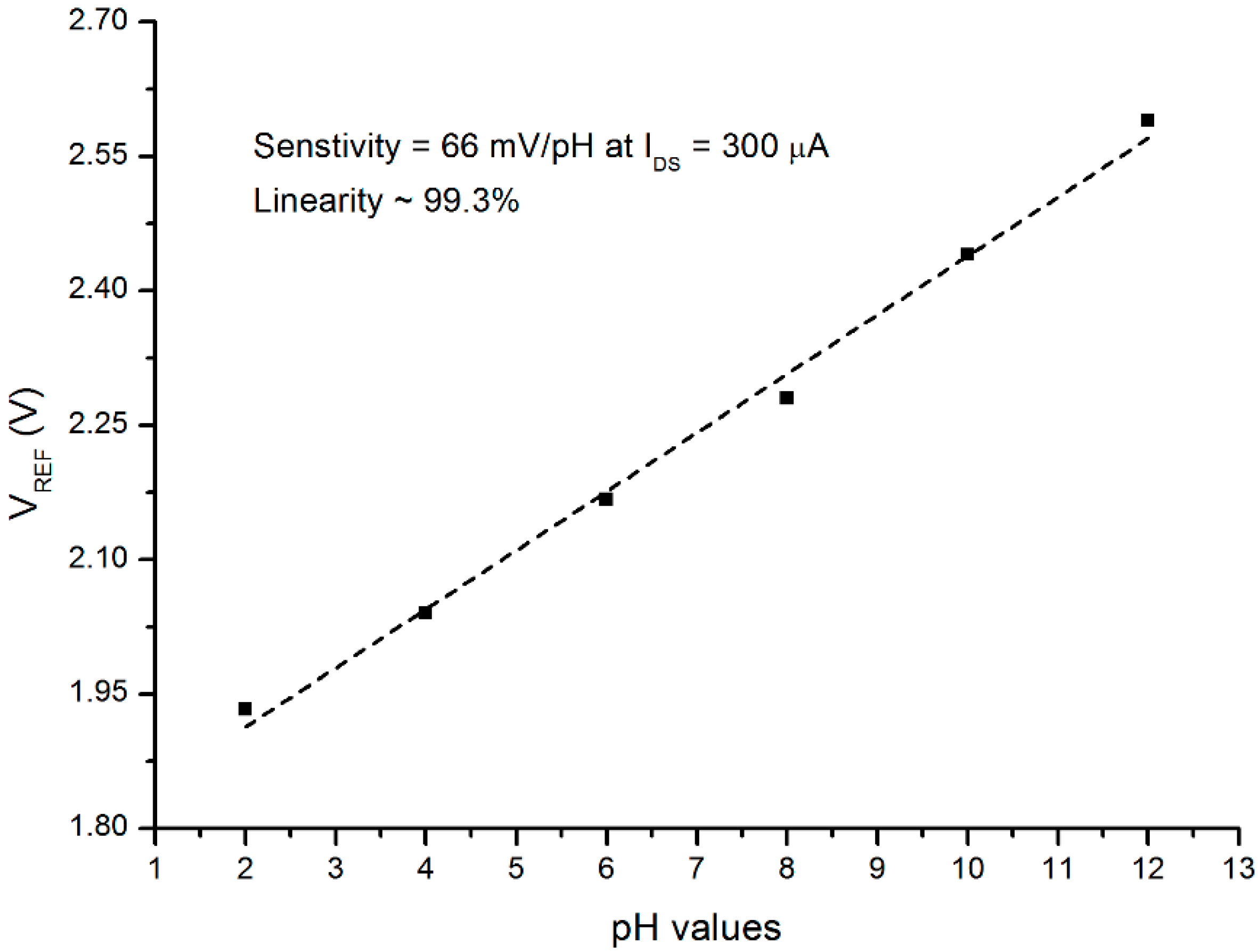
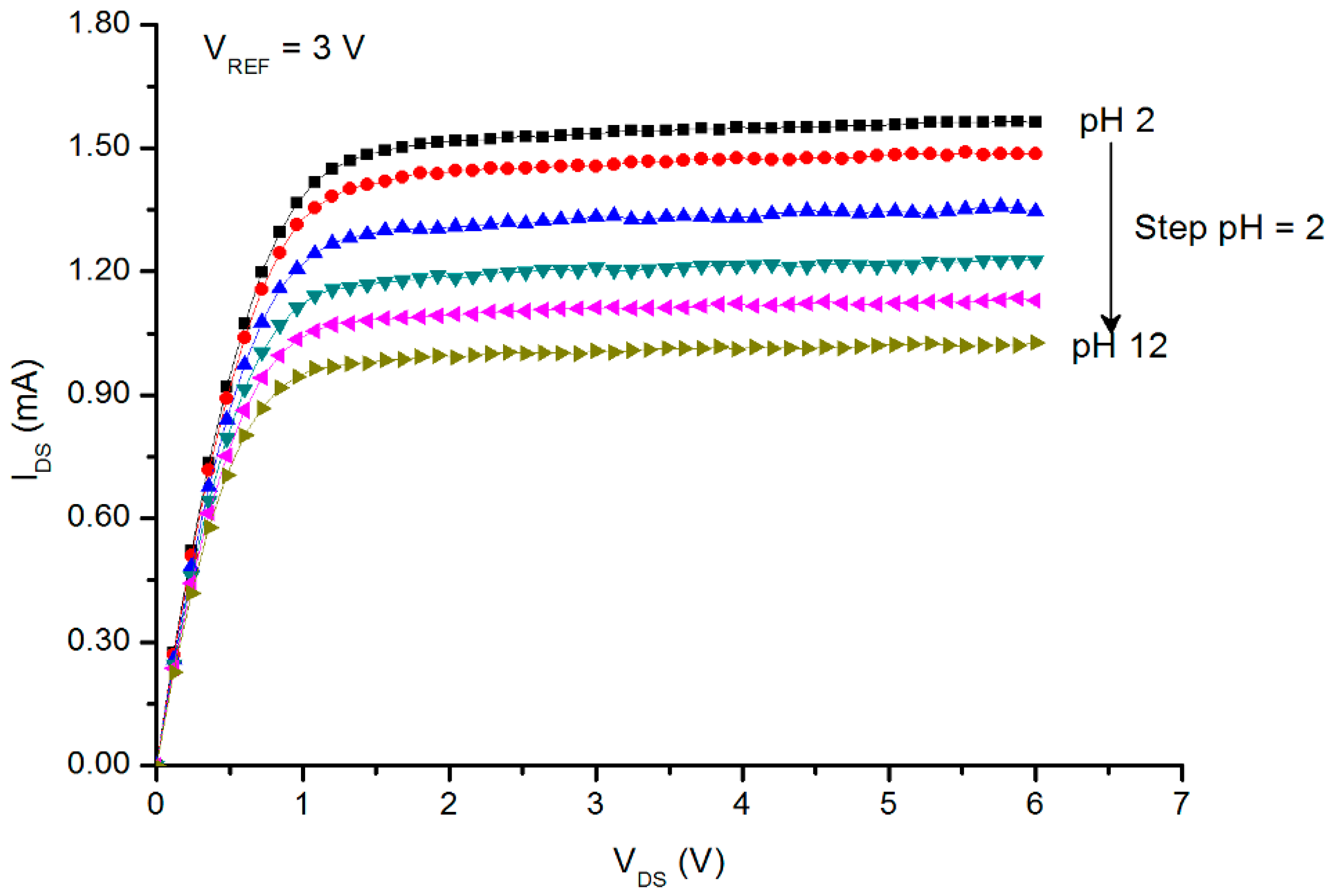


© 2016 by the authors; licensee MDPI, Basel, Switzerland. This article is an open access article distributed under the terms and conditions of the Creative Commons Attribution (CC-BY) license (http://creativecommons.org/licenses/by/4.0/).
Share and Cite
Al-Hardan, N.H.; Abdul Hamid, M.A.; Ahmed, N.M.; Jalar, A.; Shamsudin, R.; Othman, N.K.; Kar Keng, L.; Chiu, W.; Al-Rawi, H.N. High Sensitivity pH Sensor Based on Porous Silicon (PSi) Extended Gate Field-Effect Transistor. Sensors 2016, 16, 839. https://doi.org/10.3390/s16060839
Al-Hardan NH, Abdul Hamid MA, Ahmed NM, Jalar A, Shamsudin R, Othman NK, Kar Keng L, Chiu W, Al-Rawi HN. High Sensitivity pH Sensor Based on Porous Silicon (PSi) Extended Gate Field-Effect Transistor. Sensors. 2016; 16(6):839. https://doi.org/10.3390/s16060839
Chicago/Turabian StyleAl-Hardan, Naif H., Muhammad Azmi Abdul Hamid, Naser M. Ahmed, Azman Jalar, Roslinda Shamsudin, Norinsan Kamil Othman, Lim Kar Keng, Weesiong Chiu, and Hamzah N. Al-Rawi. 2016. "High Sensitivity pH Sensor Based on Porous Silicon (PSi) Extended Gate Field-Effect Transistor" Sensors 16, no. 6: 839. https://doi.org/10.3390/s16060839
APA StyleAl-Hardan, N. H., Abdul Hamid, M. A., Ahmed, N. M., Jalar, A., Shamsudin, R., Othman, N. K., Kar Keng, L., Chiu, W., & Al-Rawi, H. N. (2016). High Sensitivity pH Sensor Based on Porous Silicon (PSi) Extended Gate Field-Effect Transistor. Sensors, 16(6), 839. https://doi.org/10.3390/s16060839






